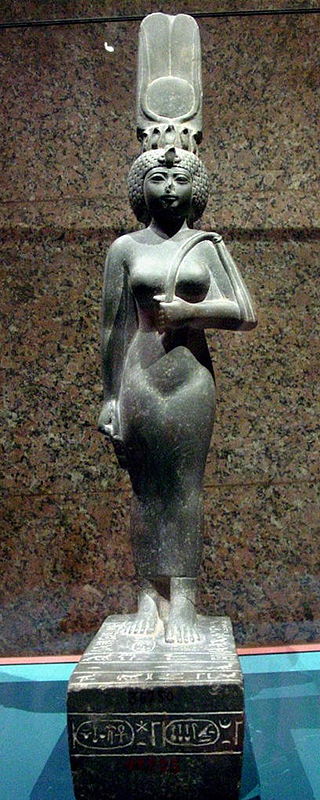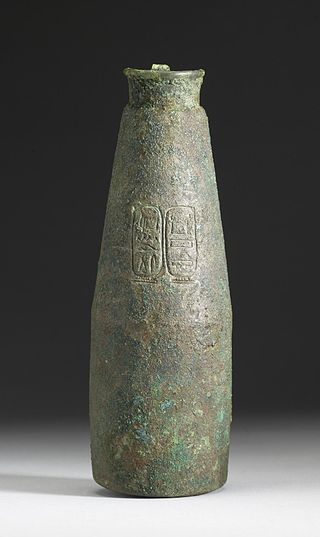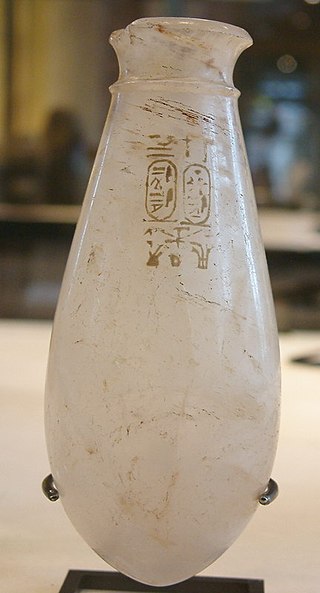
Wahibre Psamtik I was the first pharaoh of the Twenty-sixth Dynasty of Egypt, the Saite period, ruling from the city of Sais in the Nile delta between 664–610 BC. He was installed by Ashurbanipal of the Neo-Assyrian Empire, against the Kushite rulers of the Twenty-fifth Dynasty, but later gained more autonomy as the Assyrian Empire declined.

Neferkare Shabaka, or Shabako was the third Kushite pharaoh of the Twenty-fifth Dynasty of Egypt, who reigned from 705 to 690 BC. The Greek sources called him Sabacon (Σαβακῶν) and is mentioned by both Herodotus and Manetho.

The Third Intermediate Period of ancient Egypt began with the death of Pharaoh Ramesses XI in 1077 BC, which ended the New Kingdom, and was eventually followed by the Late Period. Various points are offered as the beginning for the latter era, though it is most often regarded as dating from the foundation of the Twenty-Sixth Dynasty by Psamtik I in 664 BC, following the departure of the Nubian Kushite rulers of the Twenty-fifth Dynasty after they were driven out by the Assyrians under King Ashurbanipal. The use of the term "Third Intermediate Period", based on the analogy of the well-known First and Second Intermediate Periods, was popular by 1978, when British Egyptologist Kenneth Kitchen used the term for the title of his book on the period. While Kitchen argued that the period was 'far from being chaotic' and hoped that his work would lead to the abolishment of the term, with his own preference being the 'Post-Imperial epoch', his use of the term as a title seems only to have entrenched the use of the term.

Shebitku also known as Shabataka or Shebitqo, and anglicized as Sethos, was the second pharaoh of the Twenty-fifth Dynasty of Egypt who ruled from 714 BC – 705 BC, according to the most recent academic research. He was a son of Piye, the founder of this dynasty. Shebitku's prenomen or throne name, Djedkare, means "Enduring is the Soul of Re." Shebitku's queen was Arty, who was a daughter of king Piye, according to a fragment of statue JE 49157 of the High Priest of Amun Haremakhet, son of Shabaka, found in the temple of the Goddess Mut in Karnak.
The Divine Adoratrice of Amun was a second title – after God's Wife of Amun – created for the chief priestess of the ancient Egyptian deity Amun. During the first millennium BCE, when the holder of this office exercised her largest measure of influence, her position was an important appointment facilitating the transfer of power from one pharaoh to the next, when his daughter was adopted to fill it by the incumbent office holder. The Divine Adoratrice ruled over the extensive temple duties and domains, controlling a significant part of the ancient Egyptian economy.

God's Wife of Amun was the highest-ranking priestess of the Amun cult, an important religious institution in ancient Egypt. The cult was centered in Thebes in Upper Egypt during the Twenty-fifth and Twenty-sixth dynasties. The office had political importance as well as religious, since the two were closely related in ancient Egypt.

Kashta was an 8th century BCE king of the Kushite Dynasty in ancient Nubia and the successor of Alara. His nomen k3š-t3 "of the land of Kush" is often translated directly as "The Kushite". He was succeeded by Piye, who would go on to conquer ancient Egypt and establish the Twenty-Fifth Dynasty there.

Amenirdis I was a God's Wife of Amun during the 25th Dynasty of ancient Egypt. Originating from the Kingdom of Kush, she was the daughter of Pharaoh Kashta and Queen Pebatjma, and was later adopted by Shepenupet I. She went on to rule as high priestess, and has been shown in several artifacts from the period.

Usermaatre Setepenamun Takelot III Si-Ese was Osorkon III's eldest son and successor. Takelot III ruled the first five years of his reign in a coregency with his father, according to the evidence from Nile Quay Text No.13, and succeeded his father as king the following year. He served previously as the High Priest of Amun at Thebes. He was previously thought to have ruled Egypt for only 7 years until his 13th Year was found on a stela from Ahmeida in the Dakhla Oasis in 2005.

Rudamun was the final pharaoh of the Twenty-third Dynasty of Egypt. His titulary simply reads as Usermaatre Setepenamun, Rudamun Meryamun, and excludes the Si-Ese or Netjer-Heqawaset epithets employed by his father and brother.

Shepenupet I or Shapenewpet I was God's Wife of Amun during the Twenty-third Dynasty of Egypt.

Ankhnesneferibre was an ancient Egyptian princess and priestess during the 26th Dynasty, daughter of pharaoh Psamtik II and his queen Takhuit. She held the positions of Divine Adoratrice of Amun and later God's Wife of Amun between 595 and 525 BC, during the reigns of Psamtik II, Apries, Amasis II and Psamtik III, until the Achaemenid conquest of Egypt.

Shepenupet II was an ancient Egyptian princess of the 25th Dynasty who served as the high priestess, the Divine Adoratrice of Amun, from around 700 BC to 650 BC. She was the daughter of the first Kushite pharaoh Piye and sister of Piye's successors, Shabaka and Taharqa.

The ancient Nubian princess Amenirdis II, daughter of the Kushite pharaoh Taharqa of the 25th Dynasty, was adopted by Shepenupet II, daughter of Piye, to become Divine Adoratrice of Amun from around 650 BC to 640 BC during the 26th Dynasty. Amenirdis adopted Nitocris, daughter of Psamtik I, to become her successor. She may have been married to one of Taharqa's sons, king Atlanersa.

Karomama Meritmut was an ancient Egyptian high priestess, a God's Wife of Amun during the 22nd Dynasty.

The Twenty-fifth Dynasty of Egypt, also known as the Nubian Dynasty, the Kushite Empire, the Black Pharaohs, or the Napatans, after their capital Napata, was the last dynasty of the Third Intermediate Period of Egypt that occurred after the Nubian invasion.

Mentuemhat or Montuemhat was a rich and powerful Theban official from ancient Egypt who lived during the Twenty-fifth Dynasty of Egypt and Twenty-sixth Dynasty of Egypt. He was the Fourth Priest of Amun in Thebes.

Pebatjma was a Nubian queen dated to the Twenty-fifth Dynasty of Egypt. She was the wife of King Kashta. She is mentioned on a statue of her daughter Amenirdis I, now in Cairo (42198). She is also mentioned on a doorjamb from Abydos.

Nitocris II was an ancient Egyptian princess and priestess during the reign of pharaoh Amasis II of the 26th Dynasty.

Haremakhet was an ancient Egyptian prince and High Priest of Amun during the 25th Dynasty.


















